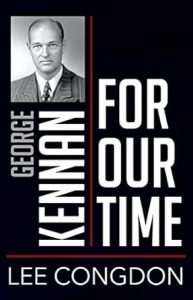Lee Congdon.

This is Congdon’s second book about Kennan: in 2008 he wrote George Kennan: A Writing Life, which assessed Kennan’s literary skills and achievements in the context of his long life (he lived to age 101) and career as a Foreign Service Officer, diplomat, policy analyst, and historian. Congdon admiringly described Kennan’s writing style as “formal, graceful, unhurried, Gibbonesque,” and concluded that Kennan, when measured by his character, writing, wisdom, and diplomatic career “was the greatest American” of the 20th century. That is a bold claim and certainly unwarranted. Congdon is on much firmer ground in his new book where he uses Kennan’s political philosophies as a road map out of our current predicament.
Kennan’s life and political thought are literally an “open book,” which includes two-volumes of his memoirs, his remarkably introspective diaries, historical works, lectures, interviews, testimonies, policy planning documents, journalism, works of political philosophy, and some excellent biographies (the best being John Lewis Gaddis’ George Kennan: A Life). Congdon is familiar with all of them. Congdon’s greatest achievement in both of his books on Kennan is concision—they both come in at about 200 pages. No words are wasted.
Congdon divides George Kennan for Our Time into three main parts: a brief biography that includes a discussion of the writers and thinkers that most influenced Kennan (Anton Chekhov, Edward Gibbon, Edmund Burke, Alexis de Tocqueville, Raymond Sontag, and Reinhold Niebuhr), Kennan’s views on foreign policy, and Kennan’s diagnoses of, and proposed solutions for, our domestic problems. And although Kennan died in 2005, Congdon shows how Kennan’s approaches to both foreign and domestic issues resonate today.
For Kennan, history was the greatest teacher—it taught tragedy, irony, contingency, prudence, skepticism, humility, uncertainty, and the fallen nature of man. History and experience counseled “realism” and restraint in foreign policy, instead of crusading interventionism. The most that a wise foreign policy can achieve in the real world is a relatively stable balance of power. The United States, Kennan believed, should not concern itself with the internal structure of foreign governments unless that structure affected a country’s foreign policy in ways inimical to vital American interests. Even then, in most instances, a strong defensive policy would suffice to protect America’s vital interests. That is why Kennan, the intellectual architect of containment of the Soviet Union, emphasized containment’s political aspects over and above its military components. Kennan never counseled a crusade against communism—he thought all such crusades in foreign policy were dangerous—but instead thought the U.S. and its allies could contain its spread into important regions of the world while allowing communism’s internal contradictions to eventually cause its “mellowing” or collapse.
Congdon credits Kennan’s passive approach to containment for America’s victory in the Cold War, but in this instance the greater credit belongs to James Burnham who advocated the policy of “liberation” that President Ronald Reagan implemented in the 1980s. Kennan may have understood Russia better than Burnham did, but Burnham understood communism better than Kennan did.
When the Cold War ended, Kennan did not celebrate and warned that U.S. policy should be geared to helping Russia develop a stable post-Cold War government. He applauded President George H. W. Bush’s managing of the end of the Cold War, especially Secretary of State Baker’s pledge not to expand NATO after German reunification. When President Bill Clinton went ahead with NATO expansion anyway, Kennan sounded the alarm in the pages of the New York Times. NATO expansion, he wrote, “would be the most fateful error of American policy in the entire post-Cold War era.” He predicted that it would result in reviving the worst aspects of Russian nationalism and imperialism. Kennan’s warnings were ignored by Clinton and all of his successors as NATO relentlessly expanded toward Russia’s western borders. Russian imperialism, as Kennan predicted, once again reared its ugly head and Ukrainians paid the price.
Kennan also spoke out against the wars in Afghanistan and Iraq as wasteful crusades to spread democracy across the Middle East. The follies of the George W. Bush administration and his successors in starting and continuing those wars proved Kennan right again. The foreign policies promoted by neoconservatives and liberal internationalists were the antithesis of Kennan’s prudent realism. And though Kennan did not live to see the deterioration in America’s relations with China, Congdon believes that Kennan would again counsel restraint and a recognition that as a great military and economic power China had vital interests of its own—including Taiwan—that we should recognize and accept.
Kennan’s views on domestic policy are less well known. He was against mass immigration. He scorned the student radicals of the 1960s who later infiltrated important American institutions and continue to do so to America’s detriment. He lamented widespread drug use, the ubiquity of pornography, and the unrestrained “sexual revolution.” “Kennan lived long enough,” Congdon writes, “to witness the decadence of the young—and not of theirs alone.” He did not live long enough to witness our current cultural situation where the word “decadence” has no meaning. Congdon notes that Kennan envisioned the end of Western civilization as occurring by the year 2050 (he may be right about that, too). He was a believing Christian in an increasingly secular age. “He attributed [America’s] social pathologies,” Congdon notes, “to a loss of, or indifference to, the Christian faith.” He lost faith in democracy, instead favoring rule by an elite composed of well-educated, refined scholars like him.
Kennan sensed that his was a voice crying in the wilderness, yet he never stopped alerting “his countrymen to the fateful road on which they were traveling.” We have traveled even farther along that road since Kennan’s death 18 years ago. Congdon hopes that reacquainting Americans with Kennan’s views could help reverse the tragic course we are following. There may not be much time left.
No comments:
Post a Comment